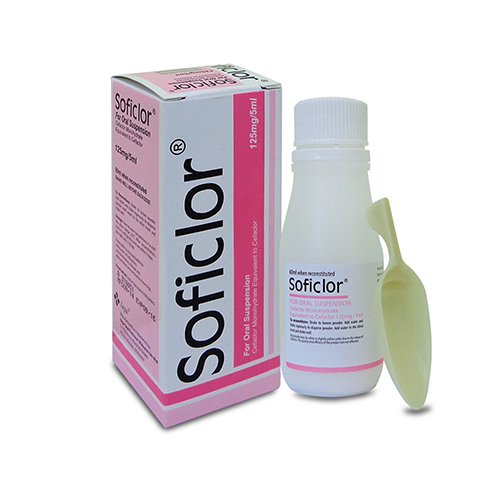
SOFICLOR Powder for Oral Susp
Therapeutic Class
Cephalosporins
Indications
Soficlor Oral Suspension is indicated in the treatment of the following infections when caused by susceptible strains of the microorganisms: Otitis media: caused by S. pneumoniae, H. Influenzae, staphylocci, S. pyogenes (group A B-hemolytic streptococci), and M. catarrhalis. Lower respiratory tract infections: including pneumonia, caused by S. pneumoniae, H. Influenzae, S. pyogenes (group A 3-hemolytic streptococci), and M. catarrhalis. Upper respiratory tract infections: including pharyngitis and tonsillitis, caused by S. pyogenes (group A B-hemolytic streptococci), and M. catarrhalis. Note: Penicillin is usually the drug of choice in the treatment and prevention of streptococcal infections, including the prophylaxis of rheumatic fever. Amoxycillin has been recommended by the American Heart Association as the standard regimen for the prophylaxis of bacterial endocarditis for dental, oral, and upper respiratory tract procedures, with penicillin V, a rational and acceptable alternative in the prophylaxis against a-hemolytic streptococcal bacteremia in this setting. Cefaclor is generally effective in the eradication of streptococci from the nasopharynx; however, substantial data establishing the efficacy of cefacior in the subsequent prevention of either rheumatic fever or bacterial endocarditis are not available at present. Urinary tract infections: including pyelonephritis and cystitis, caused by E.coli, P.mirabilis, Klebsiella sp, and coagulase-negative staphylococci. Note: Cefalor has been found to be effective in both acute and chronic urinary tract infections. Skin and skin structures infections: caused Staphylococcus aureus ard s. pyogenes (group A B-hemolytic streptococcus) Appropriate culture and susceptibility studies should be performed to determine the susceptibility of the causative organism to cefacior.
Chemical Composition
Ceracior monohydrate equivalent to cefacior anhydrous
125 mg / 5ml.
Sodium Benzoate 0.030g/60ml as preservative
Packaging
60 ml / Bot
Dosage & Administration
Soficior is administered orally. To reconstitute: Shake to loosen powder. Add water and shake vigorously to disperse powder. Add water to the 60 ml mark and shake well. Adults: The usual adult dosage is 250 mg every 8 hours. For bronchitis and pneumonia, the dosage 250 administered 3 times daily. A dosage of 250 mg administered 3 times daily for 10 days is recommended for sinusitis. For more severe infections (such as pneumonia) or those caused by susceptible organisms, doses may be doubled. Doses of 4g/day have been administered safely to normal subjects for 28 days, but the total daily dosage should not exceed this amount. For the treatment of acute gonococcal urethritis in males and females, a single dose of 3g combined with probenecid, 1g, is given. Children: The usual daily recommended dosage for children is 20mg/kg/day in divided doses every 8 hours. For bronchitis and pneumonia, the dosage is 20mg/kg/day in divided doses administered 3 times daily. In more serious infections, otitis media, and infections caused by less susceptible organisms, 40mg/kg/day in divided doses are recommended, with a maximum dosage of 1g/day. For Soficlor Oral Suspension 125mg/5ml Child's weight (kg) 20mg/kg/day 40mg/kg/day 2.5 ml t.i.d. 5 ml t.i.d. 5 ml t.i.d. 10 ml t.i.d. B.I.D. Treatment option: for the treatment of Otitis Media and pharyngitis, the total daily dosage may be divided and administered every 12 hours. Soficlor may be administered in the presence of impaired renal function. Under such a condition, the dosage is usually unchanged. In the treatment of B-hemolytic streptococcal infections, a therapeutic dosage of Soficlor should be administered for at least 10 days.
Contraindications
Soficlor is contraindicated in patients with known allergy to the cephalosporin group of antibiotics.
Warning & Precautions
General - If an allergic reaction to cefacior occurs, the drug should be discontinued, and, if necessary, the patient should be treated with appropriate agents, eg, pressor amines, antihistamines, or corticosteroids. Prolonged use of cefaclor may result in the overgrowth of non-susceptible organisms. Careful observation of the patient is essential. If superinfection occurs during therapy, appropriate measures should be taken. Positive direct Coombs' tests have been reported during treatment with the cephalosporin antibiotics. In hematologic studies or in transfusion cross-matching procedures when antiglobulin tests are performed on the minor side or in Coombs' testing of newborns whose mothers have received cephalosporin antibiotics before parturition, it should be recognized that a positive Coombs' test might be due to the drug. Cefacior should be administered with caution in the presence of markedly impaired renal function. Since the half-life of cefaclor in anuria is 2.3 to 2.8 hours, dosage adjustments for patients with moderate or severe renal impairment are usually not required. Clinical experience with cefacior under such conditions is limited; therefore, careful clinical observation and laboratory studies should be made. As a result of administration of cefacior, a false-positive reaction for glucose in the urine may occur. This has been observed with s buits aid res Ta glution so nymatic (Glucose Enzymatic Test Strip, USP). Broad-spectrum antibiotics should be prescribed with caution in individuals with a history of gastrointestinal disease, particularly colitis. Pregnancy - Pregnant Category B - Reproduction studies have been performed in mice and rats at doses up to 12 times the human dose and in ferrets given 3 times the maximum human dose and have revealed no evidence of impaired fertility or harm to the fetus due to Cefacior. There are, however, no adequate and well-controlled studies in pregnant women. Because animal reproduction studies are not always predictive of human response, this drug should be used during pregnancy only clearly needed. Nursing Mothers -Small amounts of cefaclor have been detected in mother's milk following administration of single 500-mg doses. Trace amounts were detected at 1 hour. The effect on nursing infants is not known. Caution should be exercised when Cefaclor is administered to a nursing woman. Pediatric Use - Safety and effectiveness of this product for use in infants less than 1 month of age have not been established.
Drug Interaction
There have been rare reports of increased anticoagulant effect when cefaclor and oral anticoagulants were administered concomitantly. As with other B-lactam antibiotics, the renal excretion of cefaclor is inhibited by probenecid.
Manufacturer By
Country of Origin
Malaysia

